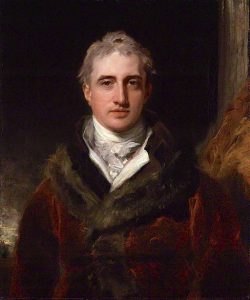
Robert Stewart, Viscount Castlereagh, 2nd Marquess of Londonderry by Thomas Lawrence c.1810. National Portrait Gallery
Lord Castlereagh was a “warm friend”1 of Lachlan Macquarie; as Secretary of State for War and the Colonies 1807-1809 he proposed the appointment of Macquarie as fifth governor of New South Wales.
I met Lord Castlereagh by accident this afternoon in Berkeley Square – and he informed me that I was to be appointed Govr. Of New South Wales – and that His Majesty had already approved thereof! 2
Lachlan Macquarie, 27 April 1809.
Macquarie was first acquainted with Lord Castlereagh in 1803, when invited to discuss the affairs of India. Lachlan had just returned from service in India and was impressed that his Lordship seemed “already very well informed”. 3 In 1809 he “earnestly solicited Castlereagh’s patronage and protection” 4 in his desire to attain the position of Governor. Castlereagh endorsed Macquarie’s request and continued to offer support and praise for the rest of his life.
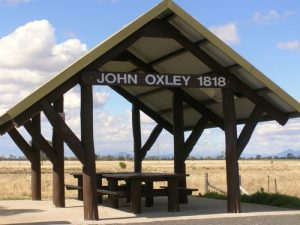
Surveyor and explorer, John Oxley, named the Castlereagh River in 1818. This monument at Gulargambone on the Castlereagh River commemorates the exploration party who camped near this spot.
Upon arriving in the Colony, one of the earliest tasks of the Governor was to upgrade the haphazard tracks and rows of Sydney’s streets: Macquarie straightened, widened and resurfaced the streets for the “Convenience and Ornament” 5 of the town, naming them in honour of the late king, the royal Dukes of Clarence, Kent and York, and Lord Castlereagh.
In 1810, during a tour of the Hawkesbury-Nepean region, Macquarie also named the township Castlereagh, in honour of his patron. Other townships established at this time were Windsor, Richmond, Wilberforce, and Pitt Town.
Lord Castlereagh’s influence continued into 1818, when the Castlereagh River, discovered by George Evans and explored by John Oxley, was named in his honour.
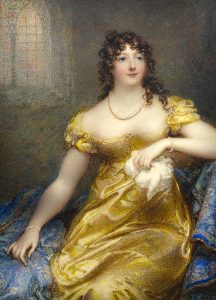
Lady Amelia Anne Stewart, Marchioness of Londonderry was a prominent figure in London’s high society. Painted by Anne Mee in 1813.
Robert Stewart, 2nd Marquess of Londonderry, known as Lord Castlereagh, was an Irish and British statesman, born in Dublin on 18 June 1769. In 1794 he married Lady Amelia (Emily) Hobart, daughter of the 2nd Earl of Buckinghamshire, John Hobart, for whom the capital of Tasmania is named.
Lady Castlereagh, as she was generally known, was an influential patroness of Almack’s, the most elite social club in Regency London. She was at the forefront of dance fashion and is credited with having introduced the quadrille to London. Lord Castlereagh, a tender and devoted husband, obviously shared Amelia’s interest in dance, as his niece attested:
“He liked the society of young people,” his favourite niece, Emma, tells us, “and far from checking their mirth and their nonsense, he enjoyed and encouraged it, with his own fun and cheerfulness …he was able to work serenely at the most important dispatches amidst the clamour of a family party, which he preferred to the isolation of his study. If an air were played that pleased him, he would go to the pianoforte and sing it; if a waltz, he would say, ‘Emma, let us take a turn,’ and after waltzing for a few minutes, he would resume his writing. His power of abstraction was indeed remarkable; our talking and laughter did not disturb him; once only do I recollect that he rose from his chair laughing, and saying, ‘You are too much.’ ”6
Viscount Castlereagh, together with Lord Liverpool and the Duke of Wellington, was one of the leading diplomats at the Congress of Vienna in 1815 – an event which settled Europe after the fall of Napoleon. The congress became famous for its lavish entertainments where the waltz dominated the ballrooms. Despite Castlereagh being heavily overworked during his time in Vienna, he still managed to attend morning dance classes with his wife.
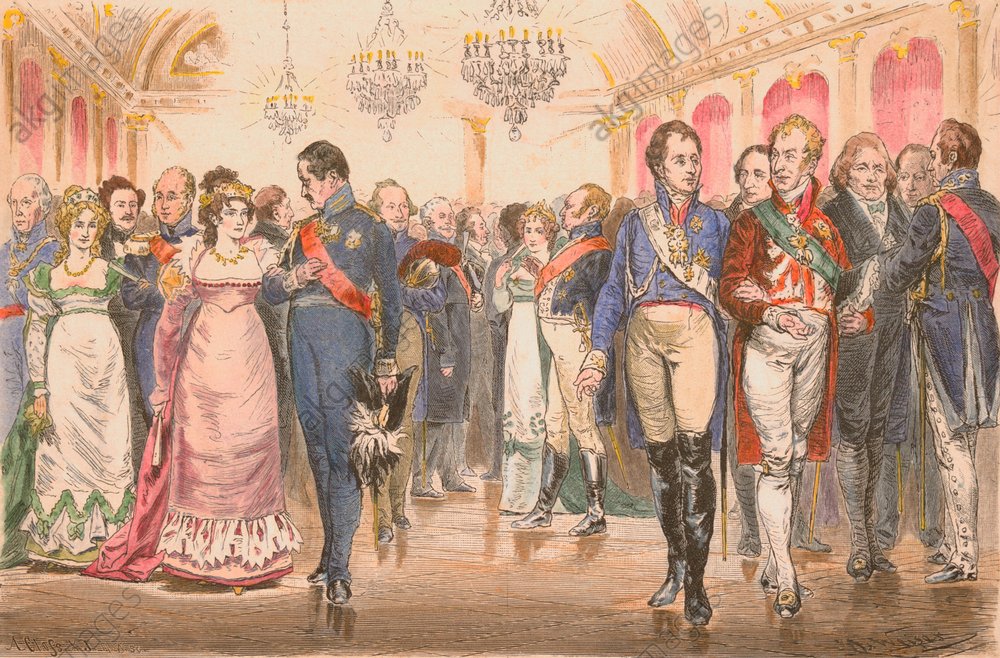
Congress of Vienna / Autumn 1814 – 9 June 1815.
“Ball at Prince Metternich’s during the Congress of Vienna”. (front f. l. Freder. Will. III of Prussia with King of Bavaria, Wellington, Metternich, Talleyrand and Hardenberg).
Thomas Wilson’s dance collection Le Sylph of 1815 celebrates the Englishmen at the Congress of Vienna with the country dances Lord Castlereagh’s Waltz, Lord Liverpool’s Waltz and The Duke of Wellington’s Waltz as well as other aristocrats in attendance: the French king with the dance Louis the XVIII, the Prince of the Netherlands with The Orange Waltz, and the sister of Tsar Alexander with The Duchess of Oldenburgh’s Favorite .7
When danced in couples, the waltz was, at first regarded as risque and immodest. However, this did not apply to country dances set to waltz tunes – Lord Castlereagh’s Waltz is an excellent example of this. The dancing master, Thomas Wilson supplied two versions of this dance in Le Sylph, An Elegant Collection of Twenty Four Country Dances, 1815.8
Governor Macquarie reportedly disliked the waltz itself, (the source of the report has not yet been identified 9); though a country dance such as this would have met with his approval.
 Le Sylph: An Elegant Collection of Twenty Four Country Dances, Thomas Wilson, London, 1815.
Le Sylph: An Elegant Collection of Twenty Four Country Dances, Thomas Wilson, London, 1815.
Listen to Lord Castlereagh’s Waltz as a midi or mp3. Download the pdf
Country dance: Longways set for three couples.
| A | 1-4 | The 3 ladies and the 3 men join hands in side lines, all advance and retire. |
| 5-8 | All advance, turn partner with two hands, ready for | |
| B | 1-8 | Poussette for three couples |
| C | 1-8 | All circle left and right. |
Repeat twice, whereupon the 1st couple will have returned to the top.
The original form of the dance is triple minor. If danced in this format only the 1st and 2nd couples dance the poussette 1½ times around each other.
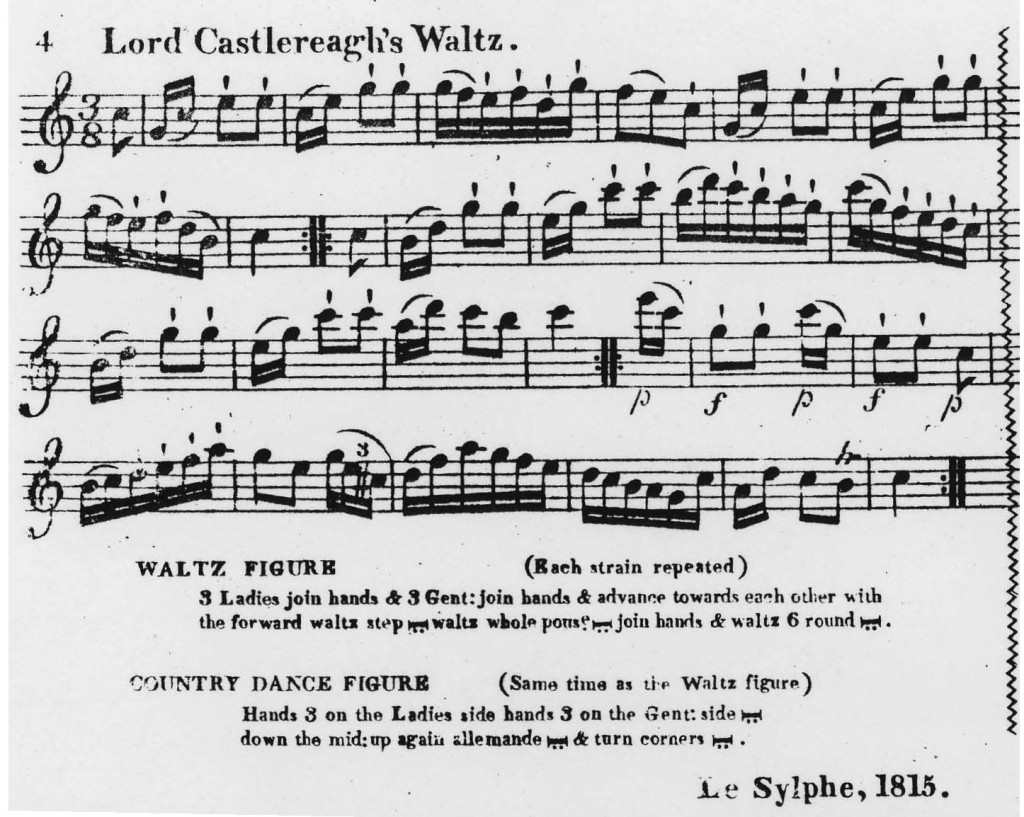
Lord Castlereagh’s Waltz from Thomas Wilson’s Le Sylphe, An Elegant Collection of Twenty Four Country Dances, 1815.
_________________________________________________________________
Sources
1 Ellis, M.H. Lachlan Macquarie. His life, adventures and times. p. 396. Angus and Robertson, Sydney 1973.
2 Dillon, Harry & Butler, Peter. Macquarie. From colony to country. p. 48. William Heinemann Australia, Sydney, 2010.
3 Ellis, M.H. Lachlan Macquarie. His life, adventures and times. p. 119. Angus and Robertson, Sydney 1973.
4 Ibid. p.167
5 Parker, Derek. Governor Macquarie. His life, times and revolutionary vision for Australia. Woodslane Press, Sydney 2010.
6 Webster, C.K. litt.d. Professor of International Politics in the University of Wales, Fellow of the British Academy, London. The Foreign Policy of Castlereagh 1812 – 1815, G. Bell and sons, Ltd. 1931. http://clclibrary-org-works.angelfire.com/castlereagh.html accessed 25 February, 2013.
7 Wilson, Thomas. Le Sylph:An Elegant Collection of Twenty Four Country Dances London, 1815. Copy supplied courtesy of Kate van Winkle Keller.
Other dances in the manual include The Serpentine Fleet, The Knight Errant, The Lyre, The Tilt, Damp Sheets, The Sheaf, Mr. Barham’s Waltz, The Rat Trap, Lord Roslyn’s Fancy, The Beggar on Horseback, Mr. Madison’s Peccavi, The Orange Waltz, The Nightmare, Lydia Bashful’s Waltz, The Hoax, Not At Home, Bacchus’s Reel, The Tomahawk, Louis the XVIII, The Castle, The Duchess of Oldenburgh’s Favorite.
8 Ibid
9 Cumes, J.W.C. Their Chastity Was Not Too Rigid. Leisure Times in Early Australia>
p.65. Longman Cheshire Pty Ltd, Melbourne 1979.
__________________________________________________________________
The information on this website www.historicaldance.au may be copied for personal use only, and must be acknowledged as from this website. It may not be reproduced for publication without prior permission from Heather Clarke.


Pingback: The 3/8 Waltz | Australian Historical Dance